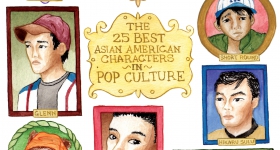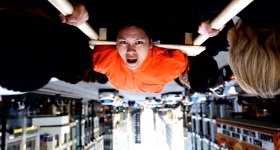“Indian Niggas ... Pakistani Niggas ... Bangladeshi Niggas ... haven’t y’all heard? We’re the new niggas!”
From the first sentence of the film Punching at the Sun, director Tanuj Chopra draws you into the gritty, racially charged world of his young main character, Mameet Nayak. While the film focuses on a South Asian teenager coming of age on the mean streets of Elmhurst, Queens, it is also one of the first films to deal with the experiences of the South Asian community in a post-9/11 world.
Since its premiere at the 2006 Sundance Film Festival—a first for a South Asian American feature film—it has created a buzz in independent film circles. Punching at the Sun recently won the Best Narrative Award at the 2006 San Francisco Asian American Film Festival. But Chopra is no stranger to film awards—his earlier short film Butterfly, a Bollywood-esque love story, won three best film awards.
So how does the 28-year-old director explain his success? “Sandwiches,” he says deadpan. “I learnt all about making a good film from learning how to order a sandwich.” He goes on to explain how his laid-back California style—Chopra originally hails from the San Francisco Bay Area—didn’t cut it in the East Coast. “See, you have to know what you want. In California, I can say I don’t want mayo or I don’t want pickles. But on the East Coast, the waiter just raised an eyebrow and said: ‘Just tell me what you want, okay?’ So today when I order a sandwich I know exactly what I want. That’s an important lesson to learn both in life and in film.”
Chopra’s interest in films began early in high school. He admits to being an indiscriminate movie junkie, spending his days watching up to three films back to back. “It was only when I saw Mississippi Masala and Bhaji on the Beach, that for the first time I realized that there were possibilities out there for someone like me,” he says.
For Chopra, that possibility was to make an honest movie about the South Asian experience. “No one walks around saying ‘Am I Kris or Krishna?’ We all have our moments of identity crisis and then we go order some nachos. A lot of the South Asian films out there don’t speak to me. I just wanted to make something that people could relate to,” he says.
Against the backdrop of the culturally diverse Queens neighborhood, Punching at the Sun explores the dynamics and tensions not only of the rage within the protagonist’s internal life, which begins to crack after the tragic death of his brother, but also looks at larger political issues affecting South Asian immigrants.
For Chopra, however, the film is mainly a story about loss. It emerged from him losing his grandparents and sensing how that changed him and his family. “I wanted to give a voice to anyone who has lost someone.”
The story also grew from his work with the South Asian Youth Action (SAYA!) community in Queens. While living and working in Elmhurst, he began mentoring media workshops and getting the youth to document their experiences after 9/11. During this time he also met members of the SAYA! basketball league whose story he weaves into the film.
Race relations play a big part of the film. Even while he was shooting the film, people would follow the crew around shouting insults and telling them to “go back to their own country.” “There is a kind of racism you grow up with in this country, whether it is internalized self-hatred or projected racism or just not seeing yourself represented in the mainstream media. And especially after 9/11, you see a different kind of racism,” Chopra says.
With a limited budget raised from friends, family and fundraisers, they had no room for mistakes. “We rehearsed for two whole months. I had a 17-day shoot schedule.” Chopra sees his film as a grassroots initiative made possible only because of the community’s donation of time, resources and services. From the antagonistic protagonist (a riveting performance by Misu Khan), to his hilarious friends (the amusing Kazi Rahman and Taran Singh), a majority of the cast were first time actors recruited from his media workshops at SAYA! Chopra said his cast and crew worked for “nothing except the dream to create a film that reflected their experiences.”
Personally for Chopra, the film has made him feel like a different person.
He admits, “I feel like there has been a great weight on my shoulders. With my last film, everyone loved it. But with this film they are being challenged. It is a political film and it’s saying something about people’s lives so there is a huge pressure of reception.”
And how has the reception been? “At the Berkeley screening most of the people really got the desi humor, at another screening at a Bay Area high school, they were cracking up about all the political stuff,” he laughs. “Mostly I think people respond to the film with their hearts.”
Chopra is currently juggling finishing school with trying to get the film distributed internationally. Not one to rest on his laurels, he is already planning his next film project on “technology and the army of super desis.” All he’s ready to give away is that it is based in the San Francisco Bay Area and is a tale about greed in the ’90s.
Sadaf Siddique is a freelance journalist based in Belmont, CA.









Comments